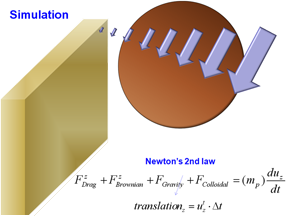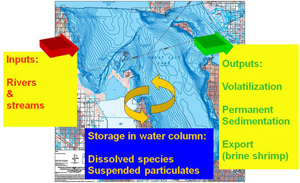Research
 |
The research in the W. P. Johnson group involves the physics and chemistry of natural water treatment by filtration in the subsurface. Additional research involves the transport of trace elements, contaminants and colloids in aquatic systems and their fate (storage, assimilation, transformation, etc). Colloids are particles in the range of several nm to several um. Biological colloids include protozoa, bacteria, and viruses; whereas non-biological colloids include mineral precipitants, manufactured colloids, and engineered nanoparticles. Research includes the Great Salt Lake and the surrounding wetlands, mining impacted areas of Ecuador and the proposed tar sand developments in eastern Utah. These studies lie at the interface between hydrogeology, geochemistry, biology, and engineering.
 |
Nanoparticle Transport. Research focusing on the physics and chemistry of natural water treatment by filtration in granular aquifers (groundwater). Studies involving the physicochemical processes governing filtration under environmental conditions.
 |
Colloidal Transport. Research in colloid transport involves understanding how filtration of pathogens and particles in natural groundwater systems occurs when traditional colloid filtration theory predicts that no filtration should occur. Research in colloid transport to date has focused on developing a mechanistic model to predict colloid deposition and release in porous media at the single grain scale. Ongoing research is focused on using the information gained from the single grain scale studies to upscale to predicting colloid transport at the field scale. This work has a wide range of applications including: understanding disease outbreaks following monsoonal events, calculating set-back distances between drinking wells and potential contaminant sources, targeted delivery of bacteria and nanoparticles for subsurface remediation and predicting the extent of pathogen transport in the subsurface.
 |
Bacterial Transport. Research is focused on understanding bacterial transport in groundwater at the field scale and how aquifer characteristics play a role in the extent of transport. This work has involved development of innovative ways of tracing bacteria in the subsurface and valuable insights to why bacteria remain in contaminated areas longer and extend further than previously thought.
 |
Solute Transport & Fate. Research focusing on the fate and transport of trace elements in aquatic systems. Studies involving the Great Salt Lake (GSL) and its surrounding wet lands. Focusing on selenium, mercury and other trace elements with proven or suspected impacts on the unique ecosystem of the area.
 |
Carbonaceous Ore. Research focusing on naturally occurring organic carbon found in sediment-hosted disseminated gold deposits within the Carlin trend in northeaster Nevada. Examining the structure and chemistry and the implication in the sequestration of gold during cyanide leaching.

